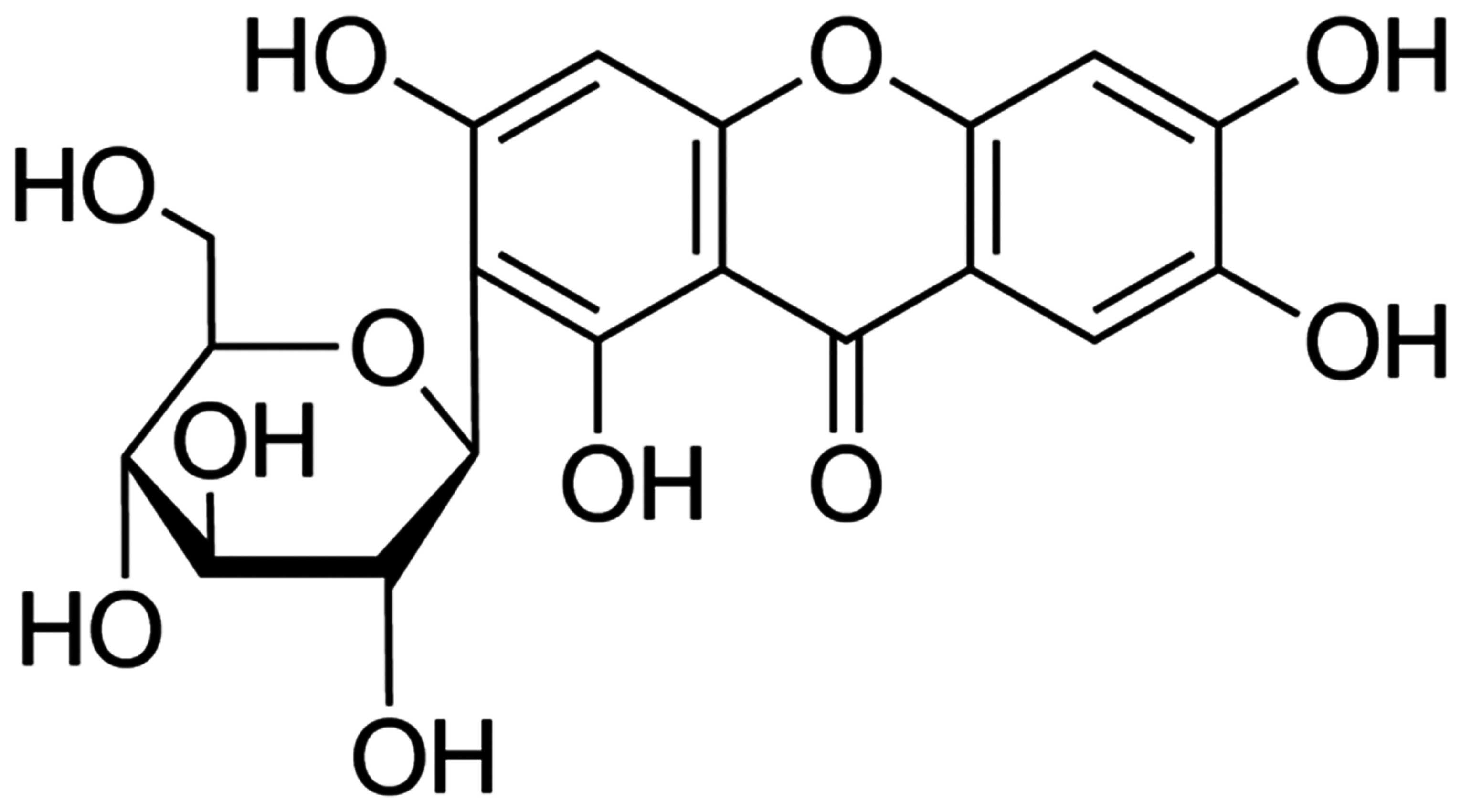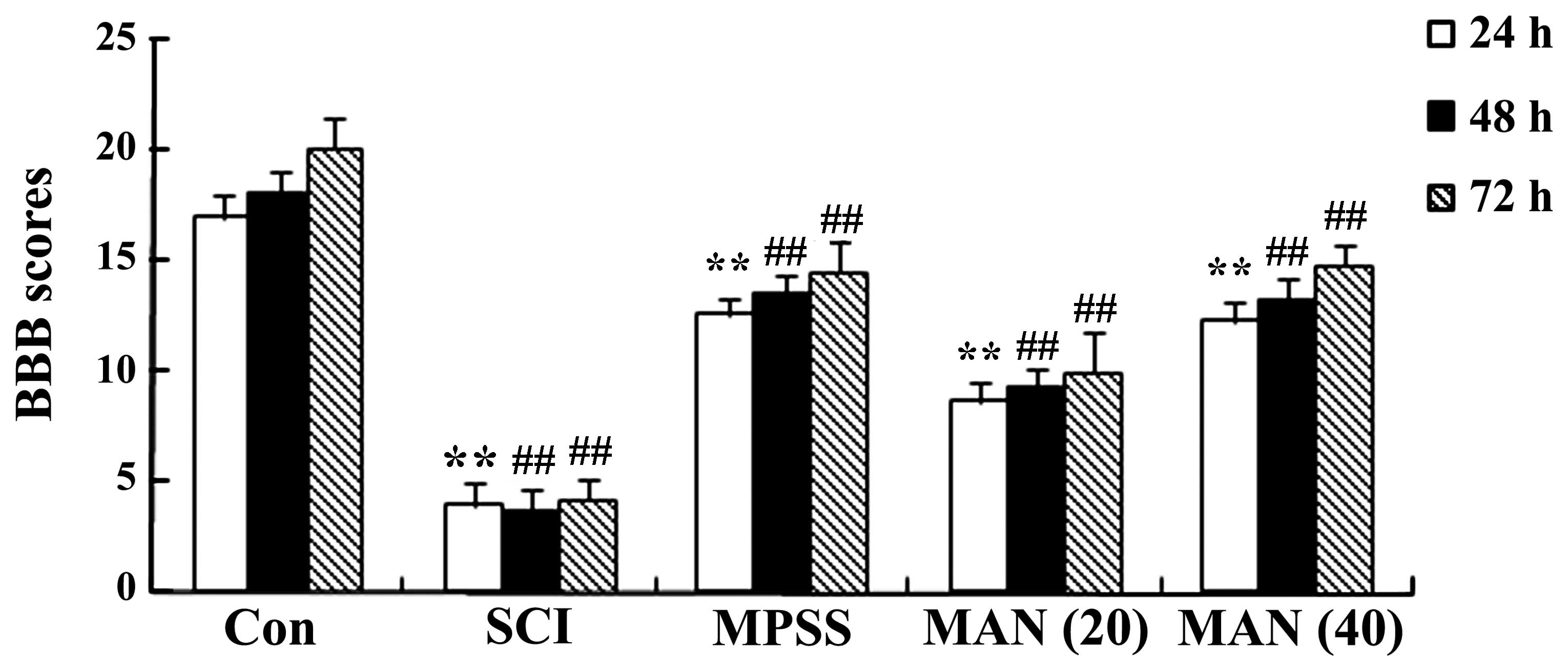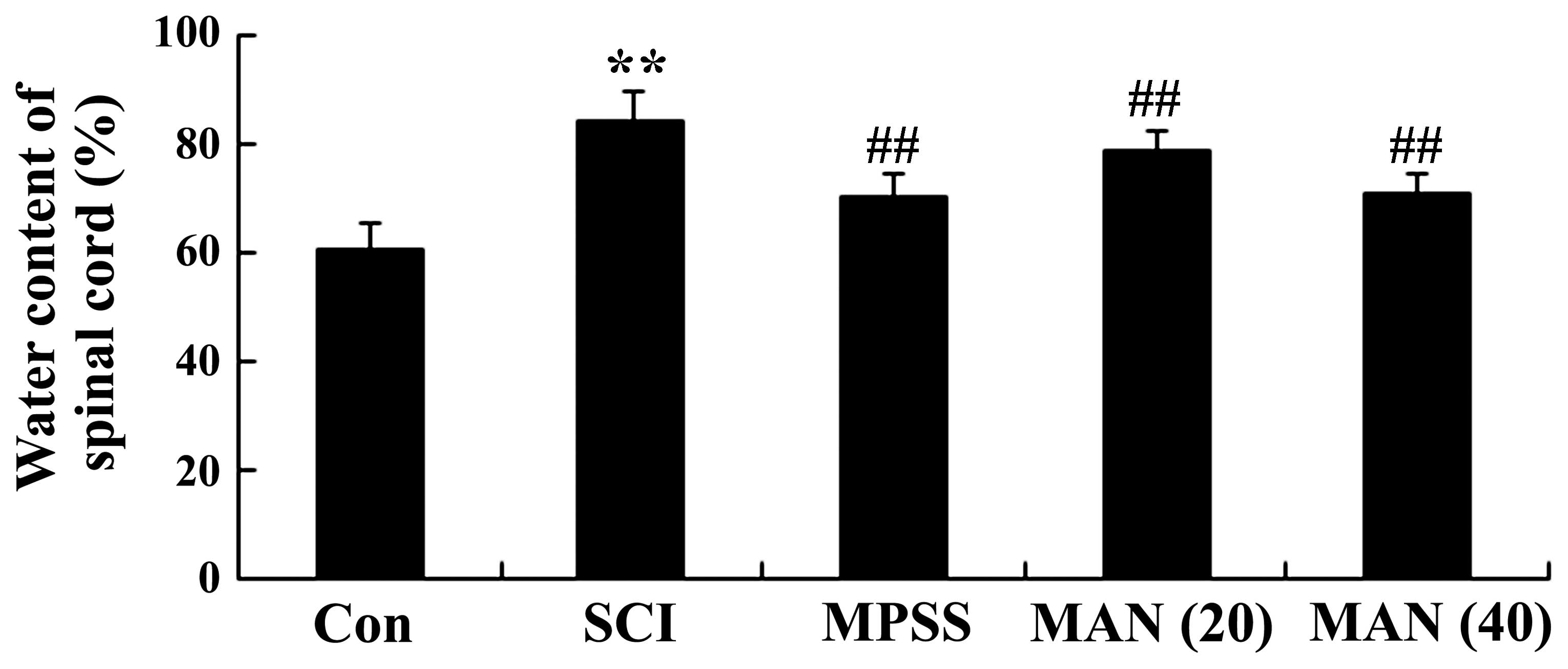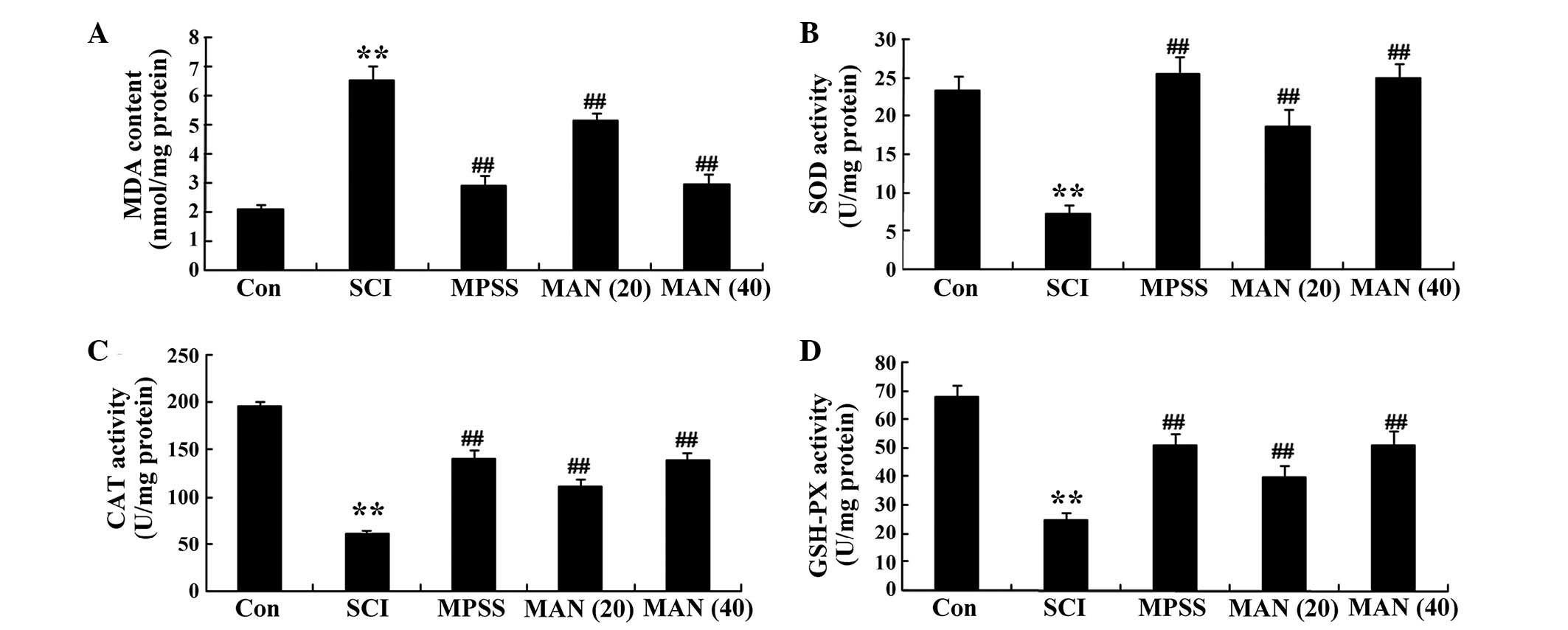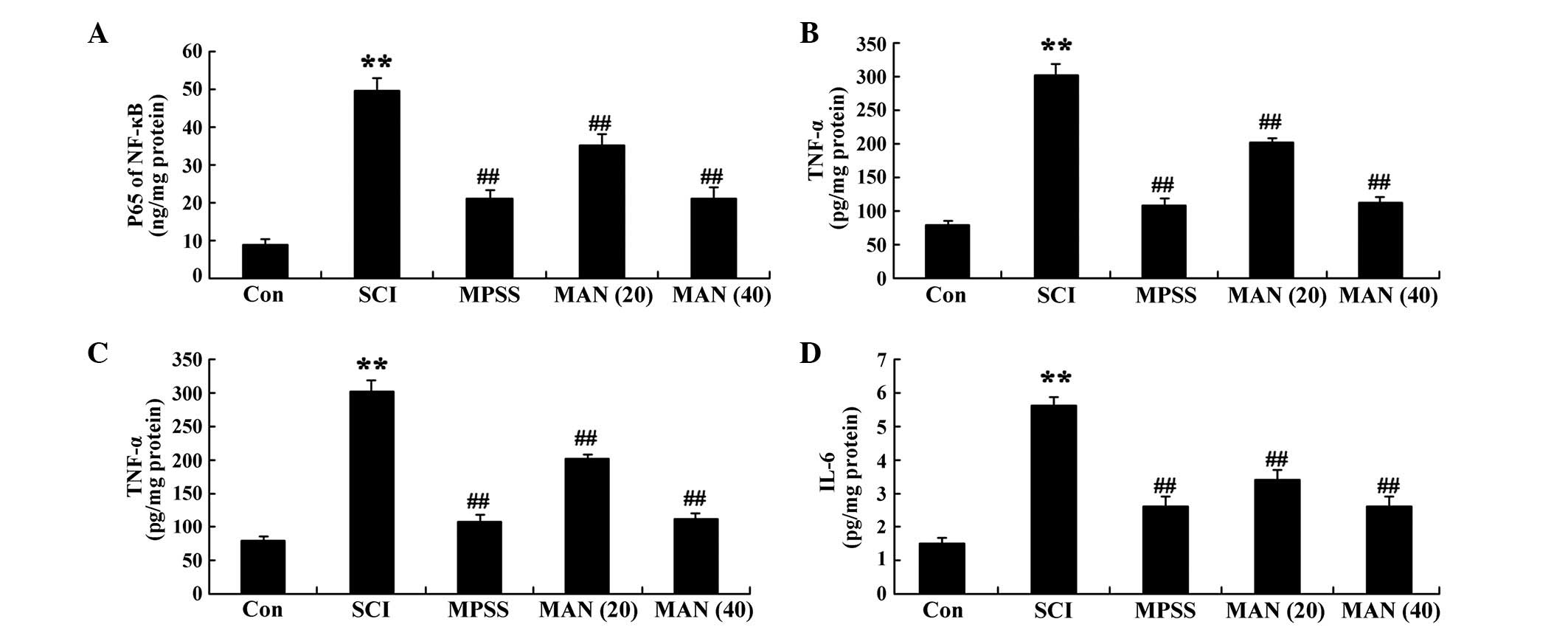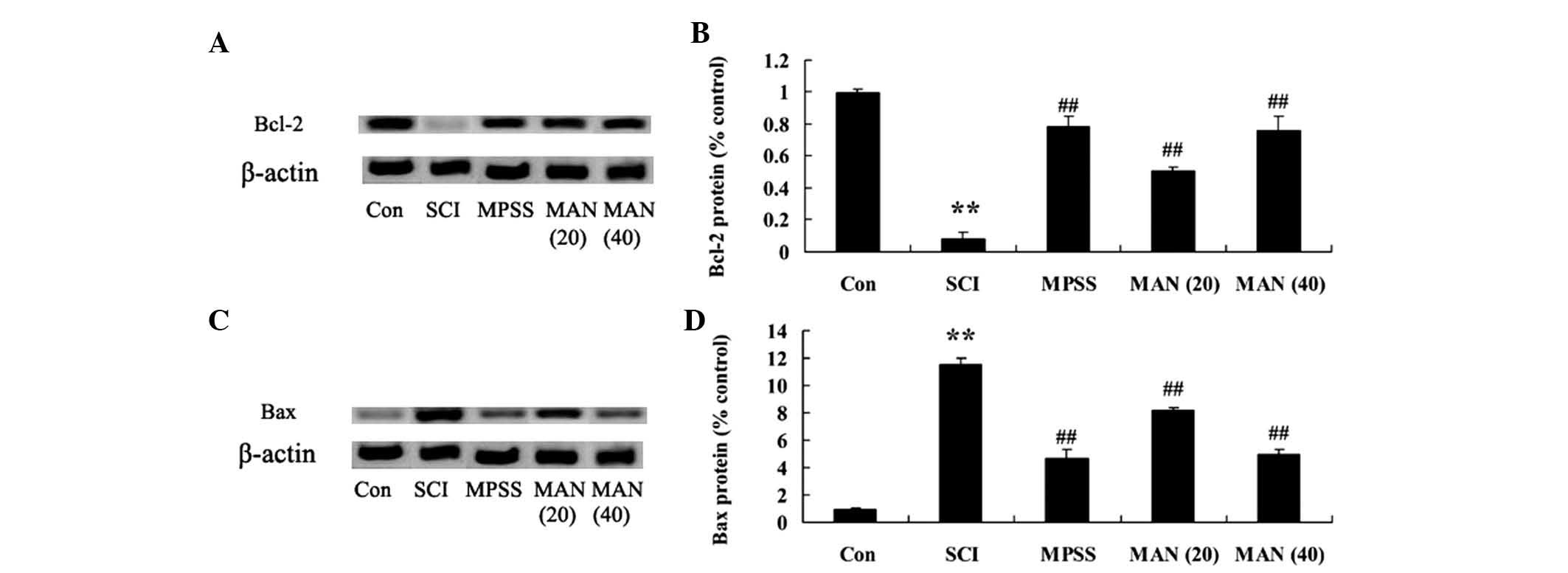Mangiferin attenuates contusive spinal cord injury in rats through the regulation of oxidative stress, inflammation and the Bcl‑2 and Bax pathway
- Authors:
- Published online on: August 28, 2015 https://doi.org/10.3892/mmr.2015.4274
- Pages: 7132-7138
Abstract
Introduction
Spinal cord injury (SCI) not only causes damage to local nerve tissue degeneration and necrosis, cavity formation and glial scar formation, but also can involve tracts, causing atrophy of the brain and cardiovascular activities of central nuclei of neurons, degeneration and necrosis, resulting in secondary damage and cardiovascular dysfunction (1,2). Oxidative stress is a series of adaptive reactions caused by the dysequilibrium between reactive oxygen in the body and the antioxidant system and, due to its importance in secondary injury in SCI, it has received increasing attention (3). Lam et al reported that the potential confounding effects of oxidative stress improved maximize functional recovery following SCI (4), and Ordonez et al found that arm-cranking exercises improved chronic spinal cord injury through the downregulation of oxidative damage (5).
Barriers to the local microcirculation leads to edema following SCI, and the release of arachidonic acid and its products, including prostaglandins, leukotrienes and thromboxane cause secondary damage to local tissue, resulting in severe inflammation, thereby causing irreversible damage to the spinal cord (6). Studies have demonstrated that, following SCI, several factors are involved in the process of apoptosis, in which inflammatory cytokine are important role. Zhang et al suggested that plumbagin protects against SCI-induced oxidative stress and inflammation through the upregulation of Nrf-2 in rats (7).
The Bcl-2 gene family is an important regulator of apoptosis in SCI, and Bax and Bcl-2 are the most representative genes in the Bcl-2 family, which are apoptotic and anti-apoptotic genes respectively (8,9). Chen et al reported that the administration of Ad-HIF-1α ameliorates neuronal apoptosis and promotes angiogenesis through the expression of Bax/Bcl-2 in SCI rats (10). Ray et al indicated that E-64-d prevented calpain upregulation and apoptosis in SCI rats through the Bax/bcl-2 pathway (11).
Mangiferin is a four-hydroxypyridine carbon glycoside, which belongs to double benzene pyridine ketones. Modern pharmacological and clinical studies have revealed that mangiferin has several physiological and pharmacological effects, including anti-oxidation, anti-virus, apoptosis regulating, anti-inflammatory, anticancer, antidiabetic, osteoclast formation inhibiting and bone resorption (12–17). However, to the best of our knowledge, detailed mechanisms regarding the effect of mangiferin on SCI have not been described. Therefore, the present study designed experiments to investigate the mechanisms underlying the protective action of mangiferin in oxidative stress, inflammation, and induction of the Bcl-2 and Bax signaling pathway induced by SCI, using rats as the working model.
Materials and methods
Drugs and chemicals
Mangiferin (purity >98%) was purchased from Nanjing traditional Chinese medicine Institute of Chinese Material Medica (Nanjing, China). In accordance with a previous report, the dosage and dosing frequency of mangiferin were selected. The chemical structure is indicated in Fig. 1. Methylprednisolone (MPSS) was supplied by the First Hospital of Jilin University (Jilin, China). Malondialdehyde (MDA), superoxide dismutase (SOD), catalase (CAT) and glutathione peroxidase (GSH-PX) commercial kits were acquired form Beyotime Institute of Biotechnology, (Nanjing, China). Nuclear factor (NF)-κB p65 unit, tumor necrosis factor-α (TNF-α), interleukin (IL)-1β, IL-6, caspase-3 and caspase-9 commercial kits were acquired from Jiancheng Bioengineering Institute (Nanjing, China).
Animals and the induction of the SCI rat model
A total of 48 adult male Sprague-Dawley (SD) rats (250–270 g) were obtained from the Animal Resource Center of the First Hospital of Jilin University. The study was approved by the Medical Ethics Committee of the First Hospital of Jilin University. The present study was performed in strict accordance with the institutional guidelines provided by the Committee on Animal Research at First Hospital of Jilin University. All rats were housed in individual cages and had free access to food and water (temperature, 22±1°C; 12-h light-dark cycle). The rat model of SCI was performed, as described previously (18). In addition, the rats were anesthetized via intraperitoneal (i.p.) injection of sodium pentobarbital (50 mg/kg; Sigma-Aldrich, St. Louis, MO, USA), containing ketamine (45 mg/kg; Sangon Biotech Co., Ltd., Shanghai, China) and xylazine (5 mg/kg; Sangon Biotech Co., Ltd.) and atropine (0.02633 mg/kg, Sangon Biotech Co., Ltd.). Subsequently, the rat model of SCI was generated by performing a laminectomy, during which the T8 and T9 vertebral peduncles were removed. The control model rats were subjected to the same laminectomy, but without compression.
Experimental groups and procedures
All rats were randomly divided into five groups: i) control group (Con; n=8), in which normal rats that received physiological saline (0.1 ml/100 g, i.p.) once a day for 30 days; ii) SCI group (SCI; n=10), in which the SCI rats received physiological saline (0.1 ml/100 g, i.p.) once a day for 30 days; iii) MPSS group (n=10), in which SCI rats were treated with 100 mg/kg MPSS (i.p.) once a day for 30 days; iv) mangiferin group (MAN 20; n=10), in which SCI rats were treated with mangiferin at a dose of 20 mg/kg once a day for 30 days; v) mangiferin group (MAN 40; n=10), in which SCI rats were treated with mangiferin at a dose of 40 mg/kg once a day for 30 days.
Evaluation of neuronal function recovery
Following SCI, the locomotor recovery was evaluated using the Basso, Beattie and Bresnahan (BBB), locomotor rating scale, between 0 and 20, in which 0 indicates no observable hind-limb movements), and 21, indicating normal locomotion (19).
Measurement of the water content of the spinal cord following SCI
The effect of mangiferin on the SCI was evaluated by determining the water content of the SCI. Rats were sacrificed by decollation. For the duration of the investigation, the SCI of all the rats were dried for 48 h at 80°C for determination of the dry weight. The water content of the SCI was obtained using the following calculations: Wet weight - dry weight / wet weight.
Evaluation of oxidative stress
Following treatment with mangiferin for 30 consecutive days, the peripheral blood was collected from the animals in each group and was centrifuged at 18,600 g for 10 min at 4°C. The supernatant was collected and oxidative stress was analyzed by determining the levels of MDA, SOD, CAT and GSH-PX in the SCI rats. According to the manufacturer's instructions (Beyotime Institute of Biotechnology), the concentrations of MDA, SOD, CAT and the activity of GSH-PX were analyzed using a microplate reader (Bio-Rad Laboratories, Inc., Hercules, CA, USA).
Evaluation of inflammatory effects
Following treatment with mangiferin for 30 consecutive days, 300 µl peripheral blood was collected from the animals in 3 rats of each group and was centrifuged at 18,600 × g for 10 min at 4°C. Following centrifugation at 18,600 g for 10 min at 4°C, the serum activities of NF-κB p65 unit, TNF-α, IL-1β and IL-6 were measured by analyzing enzyme dynamics using commercial kits, according to the manufacturer's instructions (Sangon Biotech Co., Ltd.).
Western blot analysis
Samples of the exposed spinal cord tissue (10 mg) were removed and incubated with 100 µl tissue lysis buffer (Beyotime Institute of Biotechnology) containing 2 mM EDTA, 10 mM EGTA, 0.4%NaF, 20 mM Tris-HCl and protease inhibitors (pH 7.5) for 10–15 min on ice. Subsequently, the homogenates were centrifuged at 18,600 g for 10 min at 4°C. The protein concentration of the soluble materials was determined using a Bicinchoninic Acid protein assay (Beyotime Institute of Biotechnology). Equal quantities of protein (50 µg) were fractioned on 12% sodium dodecyl sulfate-polyacrylamide gels (Invitrogen Life Technologies, Carlsbad, CA, USA), followed by transfer onto polyvinylidene fluoride membranes (0.22 mm; EMD Millipore, Bedford, MA, USA). The membranes were blocked with phosphate-buffered saline (PBS) with 5% non-fat milk to inhibit nonspecific binding sites. The membranes were then incubated with anti-Bcl-2 (sc-492; 1:1,500; Santa Cruz Biotechnology, Inc, Santa Cruz, CA, USA), anti-Bax (sc-493; 1:500; Santa Cruz Biotechnology, Inc,) and anti-β-actin (sc-130656; 1:500; Sangon Biotech Co., Ltd.) overnight at 4°C. Following incubation, the membrane was washed three times with Tris-buffered saline with Tween 20 (Biosharp, St. Louis, MO, USA) for 2 h, and the proteins were then detected by incubating the membrane with anti-mouse IgG (sc-358922; 1:1,000; Santa Cruz Biotechnology, Inc.) conjugated with horseradish peroxidase for 2 h at room temperature. The relative band intensity was determined using a gel image analysis system (GDS8000; UVP, Upland, CA, USA).
Evaluation of caspase-3 and caspase-9
Following treatment with mangiferin for 30 consecutive days, the peripheral blood was collected from each group and centrifuged at 18,600 × g for 10 min at 4°C. According to the manufacturer's instructions (Jiancheng Bioengineering Institute), the levels of caspase-3 and caspase-9 were analyzed using commercial kits at A405 nm.
Statistical analysis
Statistical analyses were performed using SPSS 19.0 software package (SPSS, Inc., Chicago, IL, USA. Data are presented as the mean ± standard deviation. Statistical analysis was performed using one-way analysis of variance followed by Dunnett's test. P<0.05 was considered to indicate a statistically significant difference.
Results
BBB scores for the evaluation of neurological function
In the present study a model of SCI in rats was establish, which exhibited persistent changes in neurological function. The results revealed that the BBB scores of the SCI model rat were reduced at 24, 48 and 72 h post-surgery respectively, compared with those of the control group (Fig. 2). However, treatment with mangiferin (20 and 40 mg/kg) of the rats in the SCI model group exhibited significantly improved neurological function and increased BBB scores, compared with the untreated SCI model group (Fig. 2). In addition, as shown in Fig. 2, the BBB scores of the rats treated with mangiferin at a dose of 40 mg/kg were similar to those obtained in the MPSS group, although not statistically significant (P>0.05).
Mangiferin reduces the water content of the spinal cord following SCI
To determine the effect of mangiferin on SCI, the water content of the spinal cord tissues were measured in the present study. As shown in Fig. 3, the water content of spinal cord was increased in the SCI model rats, compared with the rats in the control group. However, the water content of the spinal cords in the mangiferin-treated (20 and 40 mg/kg) groups were significantly lower than that observed in the SCI model group (Fig. 3). No significant difference was observed between the MPSS group and the MAN 40 group (P>0.05).
Anti-oxidative effects of mangiferin
The results of the present study revealed that the level of MDA in the SCI model rats was enhanced, compared with that in the control group (Fig. 4A). Treatment with mangiferin (20 and 40 mg/kg) reduced the concentrations of MDA, compared with the SCI model group (Fig. 4A). The results also demonstrated that the concentrations of SOD and CAT, and the activity of GSH-PX were weak in the SCI model rat group, compared with those observed in the control group (Fig. 4B–D). However, the concentrations of SOD and CAT, and the activity of GSH-PX were increased in the mangiferin-treated (20 and 40 mg/kg) groups, compared with the SCI model group (Fig. 4D). No significant difference was observed in the concentrations of MDA, SOD or CAT, or the activity of GSH-PX between the MPSS group and the MAN 40 group (P>0.05).
Anti-inflammatory effects of mangiferin
To determine the anti-inflammatory effect of mangiferin on SCI, the serum activities of NF-κB p65 unit, TNF-α, IL-1β and IL-6 were analyzed in the present study. The results revealed that SCI induced the inflammatory reaction and increased the serum activities of NF-κB p65 unit, TNF-α, IL-1β and IL-6 in the SCI model rat group, compared with those of the control group (Fig. 5A–D). However, these inflammatory factors were reduced in the mangiferin-treated (20 and 40 mg/kg) groups, compared with those in the SCI model group (Fig. 5A–D). No significant inter-group differences in inflammatory reaction were identified between the MPSS group and the MAN 40 group in the SCI model rat (P>0.05).
Astaxanthin alters the expression of Bcl-2 and Bax
A previous study reported that astaxanthin adjusts the expression levels of Bcl-2 and Bax in the SCI model rat. In the present study, the expression of Bax in the SCI model group was significantly increased, compared with that of the control group (Fig. 6A). Treatment with mangiferin (20 and 40 mg/kg) reduced the expression of Bax, compared with the SCI model group (Fig. 6A). The expression of Bcl-2 in the SCI model group was significantly lower than that of the control group (Fig. 6B). By contrast, the expression levels of Bcl-2 in the mangiferin-treated (20 and 40 mg/kg) groups were enhanced compared with that of the SCI model group (Fig. 6B). However, no significant changes amongst the expression levels of Bcl-2 and Bax were observed between the MPSS group and the MAN 40 group (P>0.05).
Anti-apoptotic effects of mangiferin
The results of the present study demonstrated that the levels of caspase-3 and caspase-9 were significantly higher in the SCI group, compared with the control group (Fig. 7A and B). However, the levels of caspase-3 and caspase-9 in the mangiferin-treated (20 and 40 mg/kg) groups were weak, compared with that in the SCI model group (Fig. 7A and B). No significant differences were observed between MPSS group and the MAN 40 group (P>0.05).
Discussion
SCI is characterized by high morbidity rates with serious complications, and treatment is difficult causing significant economic and social burdens for individuals, families and the community (20). In the present study, mangiferin significantly improved BBB scores and reduced the water content of the spinal cord in the SCI model rats. In addition, the protective action of mangiferin on SCI at a dose of 40 mg/kg was similar to that in the MPSS group.
Oxidative stress is a basic protective mechanism of the body, which is involved in the regulation of life activities, including cell signal transduction, cell proliferation and apoptosis (21). Mitochondrial dysfunction is an important factor leading to nerve cell death following SCI, which is directly associated with substantial accumulation of Ca2+ in the cells following injury (22). Oxidative stress following SCI damages ion homeostasis inside and outside the membrane, and a large quantity of Ca2+ enters into the mitochondria, accumulating inside and causing damage to mitochondria, which leads to aerobic energy metabolism, inhibiting the synthesis of ATP (23). In the present study, mangiferin effectively decreased the concentrations of MDA and augmented the concentrations of SOD and CAT, and the activity of GSH-PX in the SCI model rats. However, no significant differences were observed in these oxidative stress factors between the MAN40 group and MPSS group. Sellamuthu et al indicated that the anti-oxidative effects of mangiferin significantly increase the levels of SOD, CAT, GSH-PX and GSH in diabetic rats (24), and Viswanadh et al revealed that pretreatment with mangiferin significantly increases GSH, glutathione-S-transferase (GST), SOD and CAT activity (25).
SCI is a common type of trauma and the pathophysiological changes in SCI can be divided into primary mechanical damage and consequent secondary injury. The mechanism of secondary SCI is complex, in which inflammation is important (26). Acute SCI can activate NF-κB in glial cells, neural cells and vascular endothelial cells, causing the activation of NF-κB. The early activation of NF-κB regulates the expression levels of a series of immune and inflammatory-associated genes at the transcriptional level, inducing a variety of inflam-matory factors (27). Inhibiting the expression of NF-κB activity is key in inhibiting the inflammatory response and reducing secondary SCI (28). TNF-α, as an inflammatory cytokine with a variety of biological activities in vivo, is important in the inflammatory response and immune regulation (29). There is evidence to indicate that, following acute SCI, macrophages, microglial cells, endothelial cells and neurons can generate active NF-κB, and upregulated NF-κB can induce the RNA expression of TNF-α (30). The rapid and sustained increased expression of TNF-α is involved in SCI (31). IL-1β and IL-6 are also typical inflammatory cytokines following SCI, predominantly secreted by mononuclear macrophages, neutrophils and endothelial cells (32). The emergence of IL-1β, IL-6 and other inflammatory cytokines can increase secondary SCI. In the SCI model in the present study, mangiferin effectively reduced the serum activities of NF-κB p65 unit, TNF-α, IL-1β and IL-6 in the SCI model rats, suggesting the persistent suppression of inflammatory factors. No significant difference was observed between the anti-inflammatory effects of mangiferin (40 mg/kg) and MPSS. Gong et al suggested that the effects of mangiferin on sepsis-induced lung injury occurred viathe suppression of inflammatory factors and the upregulation of heme oxygenase-1 in mice (33). In addition, García-Rivera et al reported that mangiferin inhibits the expression levels of NF-κB p65 unit, TNF-α and IL-6 in MDA-MB231 cells (34).
Bax is the major gene involved in determining cell apoptosis in the Bcl-2 family, and promotes the mechanisms of apoptosis. Bax can promote the release of cytochrome c, activating caspase and leading to apoptosis; and Bcl-2 and Bax can combine to reduce the gene expression of Bcl-2 (35). Homodimers or heterodimers may be formed between Bcl-2 and Bax by BH1 and BH2. In order to inhibit apoptosis, Bcl-2 requires combination with Bax to form a heterodimer, and only when the number of Bcl-2/Bax heterodimers exceeds the numbers of Bcl-2/Bcl-2 homodimers and Bax/Bax homodimers, can cell apoptosis be inhibited (36). Therefore, the positive expression ratio of Bcl-2/Bax in cells directly determines whether cells undergo apoptosis. In the present study, mangiferin reduced the protein expression of Bax and promoted the protein expression of Bcl-2 in the SCI model rats. However, no significant difference was observed in the in the levels of Bcl-2 and Bax between the MPSS group and MAN 40 group. Pan et al indicated that the antiproliferative effects of mangiferin were regulated by Bcl-2 and Bax (37). In addition, Kavitha et al concluded that mangiferin attenuates 1-methyl-4-phenyl-1,2,3,6-tetrahydropyridine induced dopaminergic neurodegeneration and improves motor impairment through downregulating the expression of Bcl-2 and upregulating the expression of Bax in diseased mice (38). Pal et al demonstrated that mangiferin protects the murine liver in Pb (II)-induced hepatic damage and cell death through regulation of the Bcl-2/Bax pathways (39).
The present study demonstrated that mangiferin protected spinal cord cells by suppressing apoptosis and reducing the levels of caspase-3/9 in the SCI model rats. No significant changes in antiapoptitic effects were detected between the MPSS group and MAN 40 group. Similarly, Ghosh et al reported that mangiferin protects rat kidneys in DGal-induced oxidative stress and acute nephrotoxicity through caspase-3/9 activities (40). In conclusion, the findings of the present study established, for the first time, that mangiferin attenuated contusive SCI in rats and provided effective protection against oxidative stress, inflammation and apoptosis in the SCI rats through the Bcl-2/Bax signaling pathway.
References
|
Cizkova D, Rosocha J, Vanický I, Jergová S and Cízek M: Transplants of human mesenchymal stem cells improve functional recovery after spinal cord injury in the rat. Cell Mol Neurobiol. 26:1167–1180. 2006. View Article : Google Scholar : PubMed/NCBI | |
|
Cui B, Li E, Yang B and Wang B: Human umbilical cord blood-derived mesenchymal stem cell transplantation for the treatment of spinal cord injury. Exp Ther Med. 7:1233–1236. 2014.PubMed/NCBI | |
|
Lee JY, Maeng S, Kang SR, Choi HY, Oh TH, Ju BG and Yune TY: Valproic acid protects motor neuron death by inhibiting oxidative stress and endoplasmic reticulum stress-mediated cytochrome C release after spinal cord injury. J Neurotrauma. 31:582–594. 2014. View Article : Google Scholar : | |
|
Lam T, Chen Z, Sayed-Ahmed MM, Krassioukov A and Al-Yahya AA: Potential role of oxidative stress on the prescription of rehabilitation interventions in spinal cord injury. Spinal Cord. 51:656–662. 2013. View Article : Google Scholar : PubMed/NCBI | |
|
Ordonez FJ, Rosety MA, Camacho A, Rosety I, Diaz AJ, Fornieles G, Bernardi M and Rosety-Rodriguez M: Arm-cranking exercise reduced oxidative damage in adults with chronic spinal cord injury. Arch Phys Med Rehabil. 94:2336–2341. 2013. View Article : Google Scholar : PubMed/NCBI | |
|
Bareyre FM and Schwab ME: Inflammation, degeneration and regeneration in the injured spinal cord: Insights from DNA micro-arrays. Trends Neurosci. 26:555–563. 2003. View Article : Google Scholar : PubMed/NCBI | |
|
Zhang W, Cheng L, Hou Y, Si M, Zhao YP and Nie L: Plumbagin protects against spinal cord injury-induced oxidative stress and inflammation in wistar rats through Nrf-2 upregulation. Drug Res (Stuttg). Sep 22–2014.Epub ahead of print. | |
|
Mohammadi E, Ghaedi K, Esmailie A and Rahgozar S: Gene expression profiling of liver X receptor alpha and Bcl-2-associated X protein in experimental transection spinal cord-injured rats. J Spinal Cord Med. 36:66–71. 2013. View Article : Google Scholar : PubMed/NCBI | |
|
Liu Y, He P, Liu F, Shi L, Zhu H, Cheng X, Zhao J, Wang Y and Zhang M: Prognostic significance of B-cell lymphoma 2 expression in acute leukemia: A systematic review and meta-analysis. Mol Clin Oncol. 2:411–414. 2014.PubMed/NCBI | |
|
Chen MH, Ren QX, Yang WF, Chen XL, Lu C and Sun J: Influences of HIF-lα on Bax/Bcl-2 and VEGF expressions in rats with spinal cord injury. Int J Clin Exp Pathol. 6:2312–2322. 2013. | |
|
Ray SK, Matzelle DC, Wilford GG, Hogan EL and Banik NL: E-64-d prevents both calpain upregulation and apoptosis in the lesion and penumbra following spinal cord injury in rats. Brain Res. 867:80–89. 2000. View Article : Google Scholar : PubMed/NCBI | |
|
Agarwala S, B NR, Mudholkar K, Bhuwania R and Satish Rao BS: Mangiferin, a dietary xanthone protects against mercury-induced toxicity in HepG2 cells. Environ Toxicol. 27:117–127. 2012. View Article : Google Scholar : | |
|
Yoosook C, Bunyapraphatsara N, Boonyakiat Y and Kantasuk C: Anti-herpes simplex virus activities of crude water extracts of thai medicinal plants. Phytomedicine. 6:411–419. 2000. View Article : Google Scholar : PubMed/NCBI | |
|
Campos-Esparza MR, Sanchez-Gómez MV and Matute C: Molecular mechanisms of neuroprotection by two natural anti-oxidant polyphenols. Cell Calcium. 45:358–368. 2009. View Article : Google Scholar : PubMed/NCBI | |
|
Garrido-Suárez BB, Garrido G, Delgado R and Bosch F: A Mangifera indica L. extract could be used to treat neuropathic pain and implication of mangiferin. Molecules. 15:9035–9045. 2010. View Article : Google Scholar : PubMed/NCBI | |
|
Rajendran P, Ekambaram G and Sakthisekaran D: Cytoprotective effect of mangiferin on benzo(a)pyrene-induced lung carcinogenesis in swiss albino mice. Basic Clin Pharmacol Toxicol. 103:137–142. 2008. View Article : Google Scholar : PubMed/NCBI | |
|
Lin H, Chen R, Liu X, Sheng F and Zhang H: Study on inter-action of mangiferin to insulin and glucagon in ternary system. Spectrochim Acta A Mol Biomol Spectrosc. 75:1584–1591. 2010. View Article : Google Scholar : PubMed/NCBI | |
|
Ravikumar R, Fugaccia I, Scheff SW, Geddes JW, Srinivasan C and Toborek M: Nicotine attenuates morphological deficits in a contusion model of spinal cord injury. J Neurotrauma. 22:240–251. 2005. View Article : Google Scholar : PubMed/NCBI | |
|
Basso DM, Beattie MS, Bresnahan JC, Anderson DK, Faden AI, Gruner JA, Holford TR, Hsu CY, Noble LJ, Nockels R, et al: MASCIS evaluation of open field locomotor scores: Effects of experience and teamwork on reliability. Multicenter animal spinal cord injury study. J Neurotrauma. 13:343–359. 1996. View Article : Google Scholar : PubMed/NCBI | |
|
Liao J, Xie J, Lin D, Lu N, Guo L, Li W, Pu B, Yang Y, Yang Z, Zhang Y and Song Y: Meglumine cyclic adenylate improves neurological function following acute spinal cord injury in rats. Mol Med Rep. 10:1225–1230. 2014.PubMed/NCBI | |
|
Maher P and Schubert D: Signaling by reactive oxygen species in the nervous system. Cell Mol Life Sci. 57:1287–1305. 2000. View Article : Google Scholar : PubMed/NCBI | |
|
Al Dera H, Habgood MD, Furness JB and Brock JA: Prominent contribution of L-type Ca2+ channels to cutaneous neurovascular transmission that is revealed after spinal cord injury augments vasoconstriction. Am J Physiol Heart Circ Physiol. 302:H752–H762. 2012. View Article : Google Scholar | |
|
Xia M and Zhu Y: FOXO3a involvement in the release of TNF-alpha stimulated by ATP in spinal cord astrocytes. J Mol Neurosci. 51:792–804. 2013. View Article : Google Scholar : PubMed/NCBI | |
|
Sellamuthu PS, Arulselvan P, Kamalraj S, Fakurazi S and Kandasamy M: Protective nature of mangiferin on oxidative stress and antioxidant status in tissues of streptozotocin-induced diabetic rats. ISRN Pharmacol. 2013:7501092013. View Article : Google Scholar : PubMed/NCBI | |
|
Viswanadh EK, Rao BN and Rao BS: Antigenotoxic effect of mangiferin and changes in antioxidant enzyme levels of Swiss albino mice treated with cadmium chloride. Hum Exp Toxicol. 29:409–418. 2010. View Article : Google Scholar : PubMed/NCBI | |
|
Alexander JK and Popovich PG: Neuroinflammation in spinal cord injury: Therapeutic targets for neuroprotection and regeneration. Prog Brain Res. 175:125–137. 2009. View Article : Google Scholar : PubMed/NCBI | |
|
Bethea JR, Castro M, Keane RW, Lee TT, Dietrich WD and Yezierski RP: Traumatic spinal cord injury induces nuclear factor-kappaB activation. J Neurosci. 18:3251–3260. 1998.PubMed/NCBI | |
|
Ni H, Jin W, Zhu T, et al: Curcumin modulates TLR4/NF-kappaB inflammatory signaling pathway following traumatic spinal cord injury in rats. J Spinal Cord Med. 38:199–206. 2015. View Article : Google Scholar | |
|
Vidal PM, Lemmens E, Geboes L, Vangansewinkel T, Nelissen S and Hendrix S: Late blocking of peripheral TNF-alpha is ineffective after spinal cord injury in mice. Immunobiology. 218:281–284. 2013. View Article : Google Scholar | |
|
Yuan B, Liu D and Liu X: Spinal cord stimulation exerts analgesia effects in chronic constriction injury rats via suppression of the TLR4/NF-kappaB pathway. Neurosci Lett. 581:63–68. 2014. View Article : Google Scholar : PubMed/NCBI | |
|
Yune TY, Lee SM, Kim SJ, Park HK, Oh YJ, Kim YC, Markelonis GJ and Oh TH: Manganese superoxide dismutase induced by TNF-beta is regulated transcriptionally by NF-kappaB after spinal cord injury in rats. J Neurotrauma. 21:1778–1794. 2004. | |
|
Liu YL, Zhou LJ, Hu NW, et al: Tumor necrosis factor-alpha induces long-term potentiation of C-fiber evoked field potentials in spinal dorsal horn in rats with nerve injury: the role of NF-kappa B, JNK and p38 MAPK. Neuropharmacology. 52:708–715. 2007. View Article : Google Scholar | |
|
Gong X, Zhang L, Jiang R, Ye M, Yin X and Wan J: Anti-inflammatory effects of mangiferin on sepsis-induced lung injury in mice via up-regulation of heme oxygenase-1. J Nutr Biochem. 24:1173–1181. 2013. View Article : Google Scholar | |
|
García-Rivera D, Delgado R, Bougarne N, Haegeman G and Berghe WV: Gallic acid indanone and mangiferin xanthone are strong determinants of immunosuppressive anti-tumour effects of Mangifera indica L. Bark in MDA-MB231 breast cancer cells. Cancer Lett. 305:21–31. 2011. View Article : Google Scholar : PubMed/NCBI | |
|
Tarantino G, Scopacasa F, Colao A, Capone D, Tarantino M, Grimaldi E and Savastano S: Serum Bcl-2 concentrations in overweight-obese subjects with nonalcoholic fatty liver disease. World J Gastroenterol. 17:5280–5288. 2011. View Article : Google Scholar | |
|
Qiao WL, Wang GM, Shi Y, Wu JX, Qi YJ, Zhang JF, Sun H and Yan CD: Differential expression of Bcl-2 and Bax during gastric ischemia-reperfusion of rats. World J Gastroenterol. 17:1718–1724. 2011. View Article : Google Scholar : PubMed/NCBI | |
|
Pan LL, Wang AY, Huang YQ, Luo Y and Ling M: Mangiferin induces apoptosis by regulating Bcl-2 and bax expression in the CNE2 nasopharyngeal carcinoma cell line. Asian Pac J Cancer Prev. 15:7065–7068. 2014. View Article : Google Scholar : PubMed/NCBI | |
|
Kavitha M, Nataraj J, Essa MM, Memon MA and Manivasagam T: Mangiferin attenuates MPTP induced dopaminergic neurode-generation and improves motor impairment, redox balance and Bcl-2/Bax expression in experimental Parkinson's disease mice. Chem Biol Interact. 206:239–247. 2013. View Article : Google Scholar : PubMed/NCBI | |
|
Pal PB, Sinha K and Sil PC: Mangiferin, a natural xanthone, protects murine liver in Pb(II) induced hepatic damage and cell death via MAP kinase, NF-kB and mitochondria dependent pathways. PLoS One. 8:e568942013. View Article : Google Scholar | |
|
Ghosh M, Das J and Sil PC: D(+) galactosamine induced oxidative and nitrosative stress-mediated renal damage in rats via NF-kB and inducible nitric oxide synthase (iNOS) pathways is ameliorated by a polyphenol xanthone, mangiferin. Free Radic Res. 46:116–132. 2012. View Article : Google Scholar |



